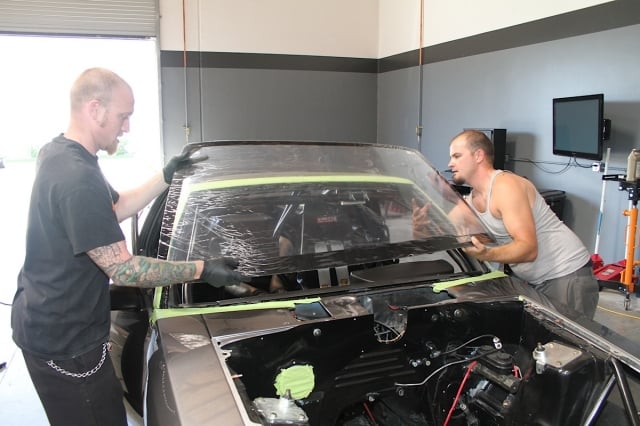
Aftermarket lexan windows offer a number of advantages over OEM factory glass, be it in a race car, a street/strip machine, or a street car or hot rod project. Some of those advantages are glaringly obvious, such as the significant weight savings and the added safety brought on by the dynamics and strength of the materials used in their construction. But lexan windows like those produced by the folks at Optic Armor Performance Windows deliver other key plusses, and to experience those advantages for ourselves, we recently took delivery of a set of Optic Armors’ much-talked-about Drop-In Blackout front and rear windows for a Fox body Mustang project vehicle of ours.

Optic Armor’s polycarbonate lexan Drop-In Blackout windows are cut-to-fit and designed as direct replacements for the OEM Fox body Mustang glass.
Optic Armors’ Drop-In Blackout line, known in simpler terms as the DIBO line, are pre-formed, ready-to-install windows, and the Fox body Mustang is but just one of the many popular makes and models of vehicles that the company has developed windows for. Others include the ’93-02 Camaro/Firebird, ’97-present Corvettes, ’08-present Dodge Challengers, and of course the ’79-present Ford Mustangs.
Optic Armor windows are made from polycarbonate, which is a thermoplastic polymer that’s easy to form and mold, and also doesn’t give up its optical clarity as plexiglass does. There’s of course more to the process than simply forming a standard polycarbonate, but optic Armor keeps that secret recipe close to the hip. What it results in, however, is a lightweight, shatter-resistant, and scratch resistant window that’s strong as an ox.
Said optic Armor’s Jim Dunham: “The DIBO line was originally developed for the street market, so that guys could take it to a glass shop, have them install it, use the factory molding, and it would look just like the factory glass. But it really evolved into a product that the chassis builders jumped on, because it helped save them a lot of time in trimming and blacking out the windows. Unless they’re flush-mounting the windows to the car, this line is perfect.”
We begin the installation process, of course, by first removing the factory glass. To accomplish this, we taped off the areas around the window to protect the paint, and then fed wire through under the window and 'sawed' back and forth to loosen the adhesive. Needless to say, it won't require as much muscle to put the Optic Armor windows in, as each of the two windows is roughly 20 pounds heavier than the lexan we'll be installing.
With the window prepped and ready, it's time to apply the urethane adhesive (your standard window glue) to the pinchweld of the body.
As Dunham explains, the two standout advantages to their windows are the weight savings and their scratch-resistant properties.
Utilizing both the front and rear windows on a Fox body such as ours, Dunham indicates that a full 42 pounds of weight is shaved from the total vehicle weight when compared to OEM glass. If you were to then include the side windows, which involve more componentry, the weight differences become even larger.
To make their windows scratch resistant (and some 250 times stronger than factory glass), Optic Armor applies a hard coat to the raw polycarbonate sheet in a proprietary process. We got our first glimpse of these windows at the PRI Show last winter, where Dunham and company were putting the capabilities of their windows on display by placing steel wool under the windshield wipers and running them back and forth throughout the show. As you might’ve guessed…not a scratch.
Once the windshield is in, we repeat the process for the rear window.
These windows are also chemical resistant (a plus for racers, as dial-in markers won’t stain the window), and quite flexible despite their strength. How strong you ask? “You can literally bend it over on itself and it won’t break,” proclaims Dunham.
As advertised, our windows arrived cut-to-fit and ready to install onto the car. After removing the factory glass, the process was pretty standard for any window installation — beginning by cutting away the urethane residue with a putty knife and cleaning the pinch welds of oil, debris, or other materials that will hinder the new urethane bonding to the remnants of the old. We simply used standard urethane adhesive to apply the lexan just as you would with glass. After situating the glass in place, we used several pieces of tape placed top to bottom and left to right to hold the windows in place while the adhesive dried. Once done, the original window moldings snapped right back into place, delivering a virtual stock-look.
Once the window is pressed into place and the adhesive is allowed to dry, we can remove the protective covering and our tape and admire the finished product.
Optic Armor recommends hard-mounting the windows to the car in some fashion if you’ll be exceeding 150 mph, even if the NHRA regulations don’t call for it. The company originally designed their windows to be glued in, and because of the nature of varying fitments on race cars, drilling of the windows is essentially a DIY project.





























